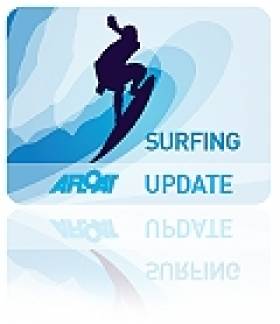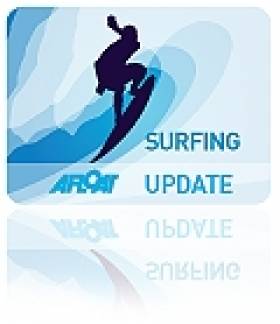Displaying items by tag: Billabong XXL Big Wave Awards
Mullaghmore Surf Produces More 'Big Wave Award' Contenders
#Surfing - Cornish surfer Tom Butler is in the running for this year's Billabong XXL Big Wave Awards thanks to this stunning ride under the crest of a giant wave off Mullaghmore Head in Co Sligo earlier this month, thanks to Storm Brigid.
But he's not the only one staking his claim in the 'Ride of the Year' category, as Ireland's Easkey Britton contributed her own Mullaghmore tube run last December.
American waveriders Will Skudin and Kurt Rist caught similarly massive swells over the Hallowe'en weekend, preceded just days before by Capetonian surfer Barry Mottershead's spectacular slide.
Less auspicious among these efforts was Peter Craig's collapse under a sudden wave break - not surprising up for 2014's 'Wipeout of the Year'. Let's see that again:
Irish Surfer, Snapper Up For 'Tube Of The Year' Gong
#Surfing - Ireland is represented for another year running on the shortlist for the Billabong XXL Big Wave Awards to be presented next month.
According to The Irish Times, Clare surfing pro Peter Conroy and Portrush photographer Roo McCrudden are in the running for the 'tube of the year' gong, which could net them a cool $5,000 in prize money.
McCrudden captured the stunning shot of Conroy riding the tube formed by an enormous cresting wave Mullaghmore in Sligo - a break that proved similarly attention-worthy for last year's 'biggest wave' nominee Ollie O'Flaherty.
Conroy told the paper that the magic wave "came out of nowhere" and that he didn't even realise just how big it was till he saw McCrudden's photographs later.
The Irish Times has more on the story HERE.
'One Epic Day of Huge Surf' Caught On Film
#SURFING - A new short film tells the story of "one epic day of huge surf" at Mullaghmore Head, as Surfer Today reports.
The Northcore film 'Fathoms Left to Fall' follows some of the world's top big wave surfers as they converged on Co Sligo to take advantage of the swell, prompted by the extreme weather system known as the 'Viking storm'.
Among the Irish riders featured is 24-year-old Ollie O'Flaherty, who has been nominated for the 'biggest wave' prize in the 2012 Billabong XXL Big Wave Awards for his monster ride at Mullaghmore.
Also nominated for his outstanding effort at the Sligo surf mecca is Andrew Cotton, a Devon native who's no stranger to Ireland's big rollers.
Irish Surfer Needs Funds to Attend Big Wave Awards
#SURFING - A young surfer from Lahinch in Co Clare is in the running for the 'biggest wave' prize in the 2012 Billabong XXL contest for his monster ride at Mullaghmore Head, The Irish Times reports.
Ollie O'Flaherty, 24, is nominated along with Devon's Andrew Cotton for the massive surf they caught off Co Sligo on 8 March last.
It was the first visit to the world-class big wave spot by O'Flaherty, a science student at NUI Galway who is a veteran of the Co Clare scene.
As previously reported on Afloat.ie, it was Cotton who tackled the biggest wave on that day - a giant 50-footer - as some of the world's top surfers took advantage of the Viking swell.
Also nominated for the $50,000 (€38,280) prize is Irish-American surfer Garrett McNamara, who last year rode what is being called the biggest wave ever surfed in the world, a 90-foot goliath off Nazaré in Portugal.
According to the Irish Independent, O'Flaherty has put out a call for sponsorship so he can attend the awards ceremony next month.
"It's a massive honor to be able to represent Ireland," he said, but added that he is "pretty much on the breadline from what I'm doing".
Should he win, the Lahinch native said he intends to "put every cent back into surfing" and replace his seven broken boards.
The winners will be announced at the Billabong XXL Big Wave Awards in Anaheim, California on 4 May.
































































